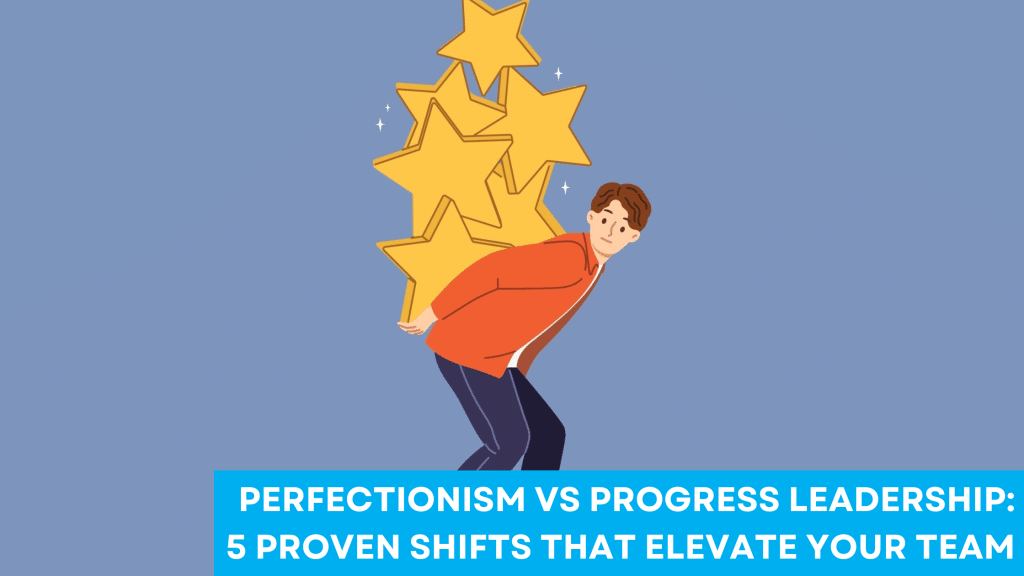Key Takeaways
- Perfectionism in leadership can boost standards momentarily — but often at the cost of creativity, speed, and team morale.
- Shifting to progress-oriented leadership fosters agility, psychological safety, and sustainable innovation.
- A clear framework helps translate the mindset shift into actionable behaviors and consistent execution.
- Practical application of the shift can reduce delays, accelerate delivery, and raise overall team performance.
- Without discipline and boundaries, “progress over perfection” can degenerate into mediocrity — balance and clarity are essential.
Why this leadership shift matters now
In technology and business today, speed matters. Market cycles shorten. Competitors adapt faster. Innovation demands quick iterations. Leaders who insist on flawless deliverables often become bottlenecks. Every delay risks missed opportunities, burnout, or loss of momentum.
That’s why reconsidering your leadership paradigm matters. Moving from perfectionism to progress isn’t a weakness — it’s a strategic advantage. When leaders adopt perfectionism vs progress leadership, they trade delays for momentum, rigidity for learning, and fear for trust. They create teams that move, adapt, deliver — not wait.
This shift isn’t about lowering standards; it’s about rethinking how and when excellence serves the goal. Below is a structured way to make that change — with clarity, discipline, and measurable impact.
What happens when leadership clings to perfection — and why that hurts
For many leaders, perfectionism feels like responsibility. High standards, thoroughness, attention to detail. Early wins reinforce the approach. But recent research paints a more nuanced picture.
A 2025 paper exploring “leader perfectionism” shows it offers a double-edged sword: while perfectionistic leaders can raise job performance via greater work passion, they simultaneously elevate performance pressure — which undermines performance for many.
Other studies document that perfectionist leadership often stifles innovation, reduces psychological safety, and suppresses team creativity. One recent article reports that perfectionist leaders who express intensity or anger toward employees significantly hinder creative thinking and risk-taking.
Moreover, managers who constantly push for flawless output expose their teams to stress, fatigue, and emotional exhaustion — leading to burnout, reduced motivation, and attrition.
In short: perfectionism may yield high-quality results — but often at a hidden cost. Speed slows. Innovation fades. People burn out.
The Perfectionism vs Progress Leadership Framework
| Key Component | Action | Example | Risk if Ignored |
| Set “good-enough” thresholds | Define minimal viable quality/standard for deliverables | Release an MVP (minimum viable product) or first draft instead of a polished final version | Endless delay waiting for “perfect”, missing market windows, stalling execution |
| Embed iterative feedback loops | Build cycles of review, feedback, and refinement | Frequent sprint reviews; draft → feedback → iterate | Mistakes accumulate, lack of responsiveness, stagnation |
| Promote psychological safety & learning culture | Encourage transparency, experimentation, and learning from mistakes | Leader shares early, imperfect work, invites honest feedback | Fear of failure, suppressed innovation, low engagement |
| Measure progress, not perfection | Focus on delivery cadence, learning, iteration count, and outcomes over flawless output | Track release frequency, time-to-market, and learning cycles | Obsession with flawless output → paralysis, missed opportunities |
5-Step Practical Guide — Shift Your Leadership Style
Step 1: Map your perfection triggers
Review recent projects. Which ones got delayed because details didn’t feel “right”? Which deliverables never shipped because you kept polishing? List those triggers.
Step 2: Define minimal viable standards for key deliverables
For recurring and strategic outputs — proposals, product releases, board decks — describe what “good enough” means. Clarity, completeness, usable, aligned with objectives. Not polished perfection.
Step 3: Implement rapid iteration and feedback cycles
Instead of going straight for final versions, deliver early drafts, prototypes, or MVPs. Hold regular, short reviews. Collect feedback. Iterate fast.
Step 4: Model vulnerability and learning publicly
Show your own drafts. Admit imperfections. Invite input. Signal that early versions are expected. Signal that learning, not shame, drives improvement.
Step 5: Recognize and reward progress, not only final polish
Celebrate delivery, iteration, and learning. Reward teams that ship, learn, and iterate. Not just the ones that deliver “perfect” artifacts — but those that deliver value and evolve.
Real-World Executive Example: Measurable Impact of the Shiftead
In a mid-sized software company, a VP of Product historically spent 35–40% of her time polishing strategy decks and release plans until they felt “perfect.” The result: long lead times, delayed launches, lost market windows, and team frustration.
After adopting perfectionism vs progress leadership, she committed to delivering “working drafts” for key deliverables. Six months later:
- Time spent in prep/revisions dropped by 45%
- Release-to-market cycle shortened by 50%
- Feature deployment frequency increased by 30%
- Team stress indicators (absenteeism, overtime spikes) dropped by 40%
- Stakeholder satisfaction (speed, responsiveness) improved markedly
Team feedback: higher autonomy, faster decisions, stronger trust.
Stakeholders: faster time-to-value, more adaptability.
This shift didn’t degrade quality — it improved flow, morale, and output. It turned constant polishing into strategic velocity.

Common Pitfalls — And How to Avoid Them
| Pitfall | Why It Happens | Solution / Guardrail |
| “Progress” becomes mediocrity or sloppy output | Lack of defined standards; “good enough” becomes too low | Define minimal viable quality explicitly; review outcomes periodically |
| Iteration yields no feedback or learning | Leaders skip review cycles under pressure | Commit to structured feedback loops; embed in process (e.g., sprints, 1:1s) |
| Team resists early drafts — perceives them as unprofessional | Cultural bias toward polish; equating draft with low quality | Normalize imperfection; lead by example; communicate the value of iteration |
| Over-commitment under the guise of “speed” | Perceiving speed as a goal rather than disciplined progress | Prioritize high-impact tasks; time-box iteration; set clear priorities |
| Leader “says” progress but “acts as” perfectionist | Mixed signals undermine credibility | Align leadership behavior with the stated framework; model vulnerability consistently |
Why This Shift Matters — And What It Unlocks
In technology and business, speed, adaptability, and learning often win over polish. Markets change. Requirements shift. Customer feedback arrives. Teams that can respond fast — iterate, adapt, learn — outperform.
Embracing perfectionism vs progress leadership delivers: agility, innovation, better resilience, healthier teams. It reduces burnout and friction. It builds psychological safety — where mistakes become lessons, not shame. It creates momentum, not gridlock.
In a world where complexity is rising and uncertainty is constant, leaders who master this shift build teams that don’t just execute — they evolve. They don’t just deliver — they improve.
Reflective Close
When you look at your calendar, project backlog, or upcoming deliverables — are you working toward perfection, or toward progress?
What’s one high-impact deliverable this week you will commit to delivering “good enough + iterate,” instead of waiting for perfect?
That one choice could unlock more performance, agility, and growth than you imagine.



